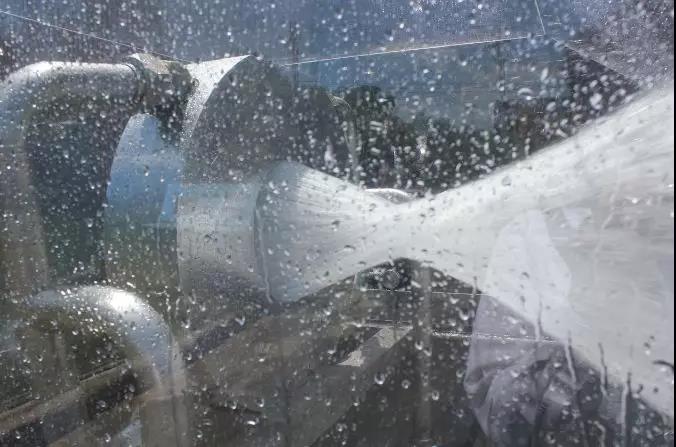On-line heat treatment method for high frequency welded pipe machine made pipe welds
- Sort:Information
- Auth:
- Source:
- Release time:2022-09-26 11:30
- Pvs:
【概要描述】The high frequency welded pipe machine HFW welded steel pipe has been continuously developed with the competition with seamless steel pipe. For welded steel pipes to gradually replace seamless steel pipes, the key is to have high product quality and low production costs. Nowadays, with the advancement of steel smelting technology, hot-rolled steel strip technology and pipe-making technology, as well as the extension of process technology to specialization, differentiation and conservation, all these have created the improvement of the quality of HFW welded pipes and the reduction of costs. condition.
On-line heat treatment method for high frequency welded pipe machine made pipe welds
【概要描述】The high frequency welded pipe machine HFW welded steel pipe has been continuously developed with the competition with seamless steel pipe. For welded steel pipes to gradually replace seamless steel pipes, the key is to have high product quality and low production costs. Nowadays, with the advancement of steel smelting technology, hot-rolled steel strip technology and pipe-making technology, as well as the extension of process technology to specialization, differentiation and conservation, all these have created the improvement of the quality of HFW welded pipes and the reduction of costs. condition.
- Sort:Information
- Auth:
- Source:
- Release time:2022-09-26 11:30
- Pvs:
The high frequency welded pipe machine HFW welded steel pipe has been continuously developed with the competition with seamless steel pipe. For welded steel pipes to gradually replace seamless steel pipes, the key is to have high product quality and low production costs. Nowadays, with the advancement of steel smelting technology, hot-rolled steel strip technology and pipe-making technology, as well as the extension of process technology to specialization, differentiation and conservation, all these have created the improvement of the quality of HFW welded pipes and the reduction of costs. condition.
In order to make HFW welded pipe take advantage of uniform wall thickness, regular geometric size and low production cost, it can also overcome the inconsistency of mechanical properties and groove corrosion caused by the existence of welds, and enter the high level occupied by traditional seamless pipes. Oil and gas pipelines and oil well pipes and other fields. With the continuous progress and development of pipe making technology, the idea of seamless welded pipe was put forward. Compared with advanced foreign countries, the market share of HFW welded pipes produced by high frequency welded pipe machine in my country is still very low, and seamless welded pipes will have a long way to go. The seamlessization of welded pipes mainly includes two connotations. One is geometric seamlessness, which uses mechanical methods and multiple hot scraping to remove burrs on the inner and outer welds of welded pipes; the other is physical seamlessness, which uses heat treatment and other processes to make the welds.The metallographic structure and mechanical properties of the heat-affected zone (HAZ) tend to be consistent with the base material.
1. On-line heat treatment of welds
1.1 Online simulation of normalizing (N) heat treatment of welds
Use intermediate frequency induction heating to quickly heat the weld to the austenitizing temperature, usually AC3 temperature plus 30-50 ℃, but should be controlled below 1010 ℃, so that the martensite structure in the weld is completely converted into austenite. The weld is air-cooled to below 700°C to avoid the re-formation of the martensite structure. Water cooling at this temperature will not change the metallographic structure, but may cause unnecessary defects such as cracks. For this reason, the weld must be air-cooled to below 370°C before water-cooling. The process layout should ensure that the welding line is air-cooled for more than 2 minutes, and for this reason, a sufficiently long air-cooling section should be designed according to the production line speed.
The main equipment is medium frequency induction heating equipment. The frequency is selected according to the wall thickness of the welded pipe to be processed, generally 1~3kHz. This process has been widely adopted in China.


1.2 On-line quenching + tempering (Q+T) heat treatment of welds
After the weld is heated to the normalizing temperature, it can be quenched by spraying water to form a very fine martensite structure, and then the weld is heated to the tempering temperature, generally 540~700℃, and air cooling is performed to complete the quenching + back The whole process of fire (Q+T) heat treatment.
Weld quenching + tempering can get better performance than normalizing, especially the toughness index of weld. This is because the martensite obtained after quenching has high strength, and the carbides obtained by high temperature tempering are distributed in granular form and distributed in the fine-grained martensite matrix, which can obtain higher strength performance than normalizing. And its plasticity and impact toughness are much better than normalizing.


From a technical point of view, these two on-line weld heat treatment methods are relatively mature. However,considering the equipment investment, operating cost and final product performance of the high frequency welded pipe machine,that is, weld heat treatment and thermal tension reducing technology.
More News

Time of issue : 2023-10-31

Time of issue : 2023-10-28

Time of issue : 2023-10-25

Time of issue : 2023-10-22
Wechat: 13392281699
Email: zty@usedpipemill.com
Company address:No. A99, East Lecong Avenue, Lecong Town, Foshan City, Guangdong Province
Recommendation
Online Inquiry
LINK
Contact Us
Tel (wechat): 13336487288
Wechat:+86 13336487288
WhatsApp:+86 13336487288
Email: zty@usedpipemill.com
Address: No. A99, Lecong Avenue East, Lecong Town, Foshan City, Guangdong Province










